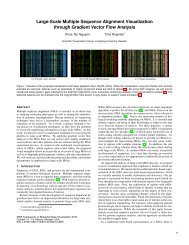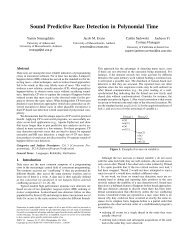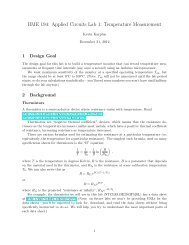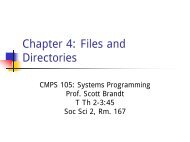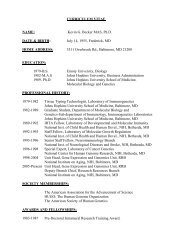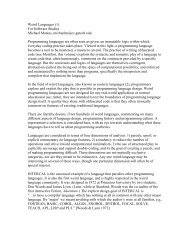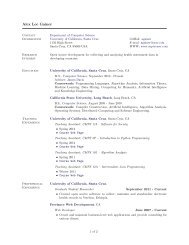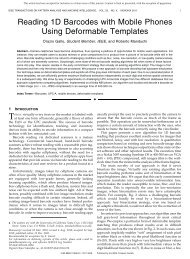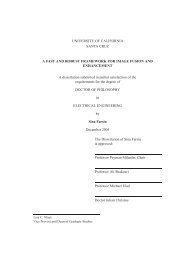Amoeba — A Distributed Operating System for the 1990s - CiteSeerX
Amoeba — A Distributed Operating System for the 1990s - CiteSeerX
Amoeba — A Distributed Operating System for the 1990s - CiteSeerX
Create successful ePaper yourself
Turn your PDF publications into a flip-book with our unique Google optimized e-Paper software.
The Directory Server is not only relied on to be up and running; it is also trusted to work<br />
correctly and never divulge a capability to an entity that is not entitled to see it. Security is an<br />
important aspect of <strong>the</strong> reliability of <strong>the</strong> directory service.<br />
Even a perfect design of <strong>the</strong> Directory Server may lead to unauthorized users catching<br />
glimpses of <strong>the</strong> data stored in it. Hardware diagnostic software, <strong>for</strong> example, has access to<br />
<strong>the</strong> Directory Server’s disk storage. Bugs in <strong>the</strong> operating system kernel might allow users to<br />
read portions of <strong>the</strong> disk.<br />
Directories may be encrypted in order to prevent bugs in <strong>the</strong> directory server, in <strong>the</strong> operating<br />
system or o<strong>the</strong>r idiosyncrasies from laying bare <strong>the</strong> confidential in<strong>for</strong>mation stored in<br />
<strong>the</strong>m. The encryption key may be exclusive-or’ed with a random number and <strong>the</strong> result may<br />
be stored alongside <strong>the</strong> directory, while <strong>the</strong> random number is put in <strong>the</strong> directory’s capability.<br />
After giving <strong>the</strong> capability to <strong>the</strong> owner, <strong>the</strong> Directory Server itself can <strong>for</strong>get <strong>the</strong> random<br />
number. It only needs it when <strong>the</strong> directory has to be decrypted in order to carry out operations<br />
on it, and will always receive <strong>the</strong> random number in <strong>the</strong> capability which comes with<br />
every client’s request.<br />
Why did we design such an unconventional file system? Partly to achieve great speed and<br />
partly <strong>for</strong> simplicity in design and implementation. The use of immutable files (and some<br />
o<strong>the</strong>r objects) makes it possible to centralize <strong>the</strong> replication mechanism in one place <strong>—</strong> <strong>the</strong> Directory<br />
Server. Immutable files are also easy to cache, an important issue when <strong>Amoeba</strong> is run<br />
over wide area networks.<br />
5 Process Management<br />
<strong>Amoeba</strong> processes can have multiple threads of control. A process consists of a segmented<br />
virtual address space and one or more threads. Processes can be remotely created, destroyed,<br />
checkpointed, migrated and debugged.<br />
On a uniprocessor, threads run in quasi-parallel; on a shared-memory multiprocessor, as<br />
many threads can run simultaneously as <strong>the</strong>re are processors. Processes can not be split up<br />
over more than one machine.<br />
Processes have explicit control over <strong>the</strong>ir address space. They can add new segments to<br />
<strong>the</strong>ir address space by mapping <strong>the</strong>m in and remove segments by mapping <strong>the</strong>m out. Besides<br />
virtual address and length, a capability can be specified in a map operation. This capability<br />
must belong to a file-like object which is read by <strong>the</strong> kernel to initialize <strong>the</strong> new segment. This<br />
allows processes to do mapped-file I/O.<br />
When a segment is mapped out, it remains in memory, although no longer as part of any<br />
process’ address space. The unmap operation returns a capability <strong>for</strong> <strong>the</strong> segment which can<br />
<strong>the</strong>n be read and written like a file. One process can thus map a segment out and pass <strong>the</strong> capability<br />
to ano<strong>the</strong>r process; <strong>the</strong> o<strong>the</strong>r process can <strong>the</strong>n map <strong>the</strong> segment in again. If <strong>the</strong> processes<br />
are on different machines, <strong>the</strong> contents of <strong>the</strong> segment are copied (by one kernel doing read operations<br />
and <strong>the</strong> o<strong>the</strong>r kernel servicing <strong>the</strong>m); on <strong>the</strong> same machine, <strong>the</strong> kernel can use shortcuts<br />
<strong>for</strong> <strong>the</strong> same effect.<br />
A process is created by sending a process descriptor to a kernel in an execute process request.<br />
A process descriptor consists of four parts as shown in Figure 3. The host descriptor describes<br />
on what machine <strong>the</strong> process may run, e.g., its instruction set, extended instruction sets (when<br />
required), memory needs, etc., but also it can specify a class of machines, a group of machines<br />
or a particular machine. A kernel that does not match <strong>the</strong> host descriptor will refuse to execute<br />
<strong>the</strong> process.<br />
Then come <strong>the</strong> capabilities. One is <strong>the</strong> capability of <strong>the</strong> process which every client that manipulates<br />
<strong>the</strong> process needs. Ano<strong>the</strong>r is <strong>the</strong> capability of a handler, a service that deals with<br />
process exit, exceptions, signals and o<strong>the</strong>r anomalies of <strong>the</strong> process.<br />
The memory map has an entry <strong>for</strong> each segment in <strong>the</strong> address space of <strong>the</strong> process to be.<br />
An entry gives virtual address, segment length, how <strong>the</strong> segment should be mapped (read<br />
BOZZA<br />
10




